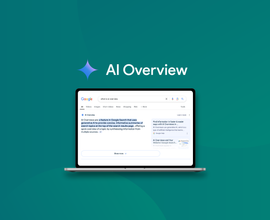Responding to and Preparing for Google Algorithm Updates
Google updates change how Google’s algorithm works, causing it to weigh website factors and signals differently, affecting a site’s rankings on SERPs. The goal of each update is to provide searchers with the most helpful and relevant answer to their query possible.
By providing strong and authoritative content to your audience, you can prepare yourself for any Google update.
Don't worry; this isn’t going to be another run-of-the-mill overview of Google algorithm updates. In this article, we'll explain how to deal with Google updates as they come and what you can do to stay ahead of the curve.
As you know, each update can cause significant changes in your rankingsRankings
Rankings in SEO refers to a website’s position in the search engine results page.
Learn more and traffic, but the worst thing you can do is overreact and make changes based on which website sections get hit the hardest. We’ll explain why in a bit as we delve into the best practices for dealing with Google updates.
What is Google’s algorithm, and why do they update it?
When we talk about Google’s algorithm, we’re referring to Google’s process of surfacing and ranking content on SERPs. Google’s goal with its algorithm is to surface content that users will find helpful based on their searches. With this goal in mind, Google periodically refines and updates the algorithm changing how it reacts to certain content factors and website signals.
The purpose of the updates is the same as the goal of the algorithm itself, to populate high-quality content to users that answer their questions and provide the best possible search experience for users. As you’ll see later, the results of these updates aren’t always what Google intended, but the aim is to create the best and fastest search experience possible.
How are Google algorithm updates rolled out?
There are a few eternal truths for every google algorithm updates:
- They are iterative
When Google performs an algorithm update, it changes how the algorithm weighs certain factors and signals. By doing so, Google needs to reprocess and recalculate an untold number of data points and search signals, which can cause some weird side effects.
While Google understands that no one update will completely resolve every issue with their platform or algorithm, sometimes, an update can actually have the opposite effect of what Google was hoping to see. Typically when this happens, SEOs take to Twitter in batches to vent their frustrations. It’s common to see Google backtrack, which we’ll focus on in more detail below. - They take time to roll out
Google algorithm updates usually take at least two weeks to roll out and very often take longer than that. For example, the rollout of the recent helpful content update took over a month to complete . Remember the massive amounts of data and signals we mentioned Google would have to recalculate and reprocess? That takes time to sift through, even though machine learning generally handles this step without human intervention. - They affect different regions at different times
Google begins by updating the algorithm in the U.S., with other countries following soon after. This is important to keep in mind if you operate in global markets or compete with international companies. Keep in mind that if you operate in the U.S., your site's content may see traffic fluctuations before many international sites. - They will affect every site differently
As an update is rolled out, everyone will see fluctuations in their traffic and rankings, but every site will be affected to a different degree. For example, it’s not uncommon for low-quality content to begin rising up the SERPs and better content to suffer in the immediate wake of a Google update, only for a return to normalcy not long after. This is why it’s crucial to be patient with Google updates. Changing content to align with the fluctuations of an update rollout is short-sighted, reactive, and could lead to calamitous falls in content quality and visibility, as we’ll cover in greater detail in a bit.
What you can expect to see during a Google algorithm update
Now that you understand how Google rolls out an algorithm update, let’s talk about some of the symptoms and side effects you’ll see in the weeks before, during, and after the update.
As we mentioned before, you’ll see volatility when an update is rolled out. It comes with the territory. That said, oftentimes, SERP volatility can indicate that an update is on the horizon before Google announces it. If you start to see strange movements in your rankings and traffic, it could mean that Google is testing new updates or has already started to roll one out.
Once an update has been fully rolled out and the dust has settled, Google will assess whether the update had the intended outcome. This assessment is based on data sets that are used to train machine learning (ML) algorithms. These data sets will include sites that Google wants to see throughout the SERP, be it at the top, middle, or bottom, as outlined in their Quality Rater Guidelines .
Based on their assessment of the update and search landscape, they may choose to roll back the update or part of it. Sometimes Google rolls out an update that works exactly as they expect, but just as often, Google makes a mistake and needs to backtrack. In cases like this, Google’s updates result in a poor user experienceUser Experience
User experience (or UX for short) is a term used to describe the experience a user has with a product.
Learn more and cause high-quality content to lose traffic.
How often does Google update its algorithm?
Google doesn’t have a set schedule for releasing updates, so we can’t point you to a date on the calendar to look out for. That said, Google is always looking for ways to create a better search experience for its users, so really, an update could come at any time.
Typically, Google will announce an update if it represents a significant change. However, sometimes SEOs see fluctuations in rankings and suspect that an update is on the way, but Google never confirms it. This is why we recommend staying connected to SEOs and experts on social media, like Google’s John Mueller , so you can stay up to date on everything happening within the industry.
What a Google algorithm update means for your content
We said it before, and we’ll say it again. In the wake of a Google update, prepare for some rankings and traffic volatility. No matter how strong your current content is, some may plummet down the SERP, while other low-quality content jumps to the top 10 for seemingly no reason.
Although this may be nerve-racking at the time, remember that it’s a natural part of the google SEO update process, and the fluctuations won’t last forever. Drops in rankings caused by an update do not necessarily indicate that you have poor content. Given the limited insight into any one update, your content may suffer for several reasons. In the face of unexpected rankings shifts, you should keep an eye on your content and wait for the dust to settle before making changes.
How to respond to a Google algorithm update
After Google fully rolls out an update, it’s important to do the following:
- Don’t panic. People make poor decisions when they’re feeling panicked, and it’s no different when it comes to Google updates. You should only make large changes to your content when you know exactly what improvements to make. In the immediate aftermath of an update, you probably won’t have enough insight into what content or signals Google is prioritizing. So, it’s important to leave your content as is for now or risk causing more damage to your site in the long term.
- Perform a content audit. Once the rollout is complete and confirmed by Google, you should see how your content has been affected. Take an in-depth look at your content by running a content audit. See what has suffered and try to understand why based on what you know about the Google update.
Once you know how your content stacks up and the algo update's goal, you can decide on the right content optimizations to make. Some pieces will be outdated or thin and can be cut, while others have strong content that can be salvaged and optimized to drive greater traffic. But don’t be hasty. You need to take a good hard look at your content to see what’s best for your overall site. - Follow Google’s SEO best practices. Remember E-E-A-T. Standing for Experience, Expertise, Authoritativeness, and Trustworthiness, this is Google’s acronym for content creation. Creating content that checks these boxes will go a long way toward providing your audience with the best possible search experience, something that tools like ChatGPT can’t do alone.
Beyond the simple acronym, Google provides a running guide of best practices to keep in mind when creating content for search. At its core, Google’s best practices are mainly geared toward creating content that is helpful for your target audience. Still, no one fully understands every aspect of Google’s ranking factors, so it’s best to follow Google’s guidelines.
How to prepare for the next Google algorithm update
Remember that Google doesn’t set a schedule for these algo updates, which makes it impossible to prepare for specific updates. A best practice is to stay prepared for an update because one can happen anytime. The best way to do that is by following Google’s SEO best practices. At a baseline, this is a good place to start preparing, but drilling down more specifically, here are some concrete ways to prepare for any Google update before it hits your website:
- Create helpful and authoritative content. This falls right in line with Google’s best practices. Creating helpful, value-driven content should be your north star for content creation. If you create all of your content with this in mind, you’ll be able to weather any Google update. Sure, some odd fluctuations may happen, and there will always be more to optimize, but Google’s stated mission is to get helpful content to their searchers that are relevant to their query. Provide that content, and the rest will take care of itself.
- Follow Google and industry leaders on social media. We alluded to this already, but it bears repeating. Keeping your finger on the pulse of the industry is a great way to stay informed about Google and any incoming updates. Even if Google doesn’t communicate something themselves, rest assured there will be tons of chatter within the community and insights from thought leaders, like Glenn Gabe , Barry Schwartz , and Lily Ray .
- Keep an eye on your content. How can you see if an update is affecting your content if you don’t know how that content is already performing? While an audit is a nice step, it’s only part of what you can do to stay on top of your content. Platforms like ContentKing , offer up-to-the-minute insights and updates on all your content, so you don’t have to worry about running an audit every time you see your rankings change. ContentKing offers the freshest information possible so you can see any traffic fluctuations immediately, which can help identify if an update is on the horizon.
A recent history of Google algorithm updates
Over the years, Google hasn’t stopped iterating on its algorithm. Determined to create as helpful a search experience as possible for its users, Google rolled out at least ten updates in 2022 alone, and those were just the updates they confirmed . Some of those updates to be aware of are:
- Helpful content update : Aims to reward content visitors feel provides a satisfying experience. Meanwhile, content that doesn't meet visitors' expectations won't perform as well.
- Product reviews update : Seeks to reward high-quality product reviews that provide insightful analysis, original research and are written by experts who know the topic well.
- Search spam update : Made significant improvements to Google’s existing search spam detector and filtering systems to remove more spammy results from SERPs.
The goal of the updates, as always, was to give users the right answers to their queries as quickly as possible, but they specifically did this through updates meant to promote helpful content and devalue content Google viewed as spam.
Wrapping it up
At the end of the day, every Google update is different. They are rolled out with different intentions to solve different problems, so it’s nearly impossible to fully plan for the effects of a specific algorithm update before it rolls out. That said, the overarching goal of each update is to create a better search experience for its users, surfacing helpful content and pushing down thin or irrelevant content; each update may take a different route to get there. In short, create strong, helpful content relevant to your audience, and you’re in a great position to weather any update Google throws at you.







